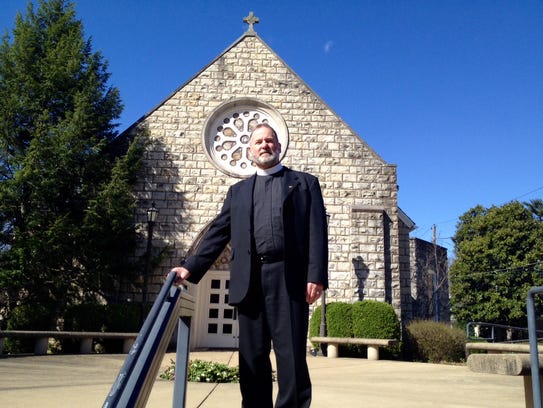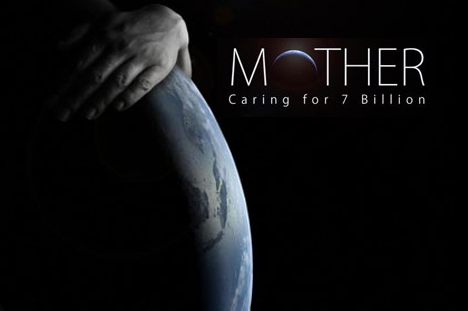 The Most Reverend Frederick F. Campbell, Bishop of the Diocese of Columbus, delivered the inaugural presentation of the Ohio State University Religion and Ecology Lunchtime Lecture Series by discussing Catholic tradition and Pope Francis’s environmental encyclical letter, Laudato Si’, on Wednesday, March 23, 2016.
The Most Reverend Frederick F. Campbell, Bishop of the Diocese of Columbus, delivered the inaugural presentation of the Ohio State University Religion and Ecology Lunchtime Lecture Series by discussing Catholic tradition and Pope Francis’s environmental encyclical letter, Laudato Si’, on Wednesday, March 23, 2016.
Bishop Campbell highlighted four themes in his talk, including how Catholicism has considered nature for 2,000 years, a Catholic imagination of nature, historical trends of alienation from nature in the Western world, and a discussion of how sin – light and shadow of the world together – plays a role in our ecological situation.
Campbell began by noting the shift, particularly in American sensibilities of nature over the last 200 years, where “nature” would have more likely evoked the image of a cultivated field for the ancients such as the poet Virgil; by contrast, modern Americans might think first of a wilderness scene of mountains or forest when describing “nature” – something Virgil would have seen as chaos. He also commented on how our image of the human in nature has changed as we’ve shifted away from agrarian roots. Not long ago, Campbell suggested, most people still had a relationship with the soil, through gardening, canning, hunting, and the like (and from the lack of air conditioning!), but now we have grown distant from a sense of seasons and cycles, and of being subject to the variations of nature. The increase in the power of science and technology in that last 200 years has influenced how we imagine nature, which in turn influences how we treat nature.
The Bishop then described what he called a “Catholic imagination of nature,” in which the created order is seen as a revelation of the nature of God, though not confused with being God. “Nature teaches us who God is and how God relates to us,” said Campbell, but God’s presence in nature does not mean that God is enclosed in nature. “The human person is a part of that order, but also apart from it,” said Campbell, acknowledging the spiritual aspect of human nature as beings created in the image of God, in whom God breathed spirit. Campbell described the creation of humans in Genesis, of Adam being created from the “dust” (In Hebrew: Adam created from the adamah; the human created from the humus; the “dust man” created from the dust), and thus the human person is from the earth, but also made living by the breath of God’s spirit, and created uniquely in the image of God; thus humans are now the link between material creation and spiritual reality.
The Bishop also noted that the Exodus story of salvation presents the creation as an act of salvation, saving us by bringing us into existence, and thus revealing a divine purpose to creation. “Creation is a gift — we are not the authors of our own existence, ” said Campbell, indicating that the whole of nature is contingent. So we are to receive nature as a gift, but yet more often modern humans have seen nature just as raw material. So why did this view go wrong?
From the Catholic perspective, humans were given a fruitful garden, as co-creators with God, but also given some restrictions (don’t eat the fruit of the tree…), and human sin – opting to take control of human destiny rather than trusting God’s provision – “divided humans from God, others, and nature, and created a kind of darkness of mind.” According to Catholic tradition, this made humans incapable of achieving our purpose without God’s grace.
Bishop Campbell then highlighted some particular passages, including Isaiah’s prophecy of the peaceable kingdom, with the idea of the lion and the lamb lying down together, as an image suggesting the peaceable kingdom requires the peace of nature. He described an Easter hymn that draws from the prophet Ezekiel’s vision of water flowing from the steps of the temple, with fruit trees on either side — fruit that will be for food, and with leaves for healing, with the water flowing from the temple nourishing all life. These images of the power of water and the sacramentality of nature suggest how nature can speak of divine realities, echoed in the use of elements like water, oil, and wine in Catholic liturgy, and perhaps quintessentially in the priest’s prayer in the center of the eucharistic celebration: “Blessed are you, Lord God of all creation, for through your goodness we have received the bread we offer you: fruit of the earth and work of human hands, it will become for us the bread of life.” Here we see nature taken up through the work of human hands, nature itself glorifying God, with humans occupying a priestly, spiritual role of encouraging nature to become part of the worship of God.
Campbell also noted the influence of the image of nature and of the desert, where early Christian monks would go in order to clarify things, to remove distractions from the reality of God, and to undertake sincere self-examination, such that the desert wilderness becomes a place for the possibilities of renewal. However, Campbell described how these aspects of sacramental devotion to the earth were challenged with the emergence of the New Science in the 17th century, and with the ideas of figures like Francis Bacon, who sought to “bend nature toward our will” or Galileo’s intention to “pull nature’s secrets from her.” Suddenly, said Campbell, there was a new attitude toward nature, as something that resists us, so that we must control her for human purposes, and for our flourishing. Campbell noted that figures like Blaise Pascal began to worry about this, but nonetheless this started a process of alienation from nature and from each other, where people began to believe we could perfect ourselves in an endless progression of material growth and progress – the very same sort of progress that Pope Francis describes as a myth in Laudato Si’.
Campbell also noted that there are always two sides to technological development – on the one hand, human creativity and ingenuity, such as in medicine, or advances like indoor plumbing or reliable heating, but on the other hand, a dark side, where our discoveries can also be used for great evil (such as penetrating the mysteries of the atom, but then creating a bomb). Even medical technology can be turned against us, said Campbell, if the human person becomes just a set of medical problems, and not a human person endowed with dignity.
Finally, Bishop Campbell reflected on the duty of parents to teach their children, and said we need a change in attitude about the meaning of human life. “We’ve lost some capacity to understand what is the good life, and we’ve substituted the goods life,” focused on what we possess. But how do we know when we’ve accumulated enough? For Americans (the rich), said Campbell, the challenge has been to see what happens when we have vast wealth without correspondingly great responsibilities. Coupled with the loss of relationship to land, and our loss of relationships with others (since we are fundamentally made for others, and do not become human without relationships), the roots of ecological crisis are evident.
People of faith, and indeed, all people, as Laudato Si’ suggests, are called to work together to meet these challenges, and this work must take many forms. To name only a few: we can work on simple things, such as giving thanks such as prayer at meals; we can rediscover the good of making things by our own hands; we can clarify what is important and set limits so we will know when it is enough; and we can set about the the perennial work of growing, making, and flourishing as an act of gratitude and blessing, offering our work and creation itself to God in praise.










